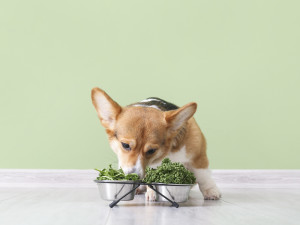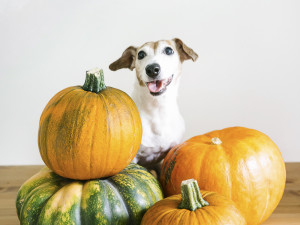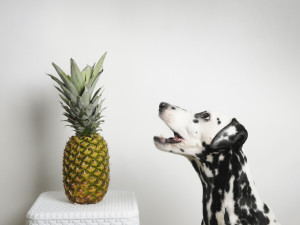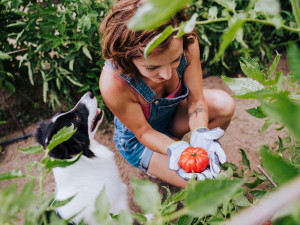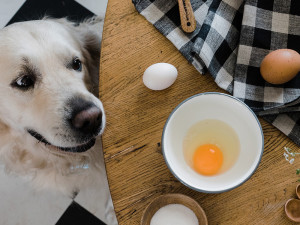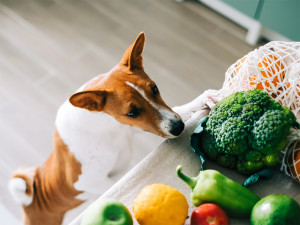Can Dogs Eat Zucchini? How to Feed This Veggie to Your Pup
What should know before adding this food to your pup’s diet.

Share Article
You may wonder: why would a dog want to eat zucchini? Well, many dogs, as you probably know, will eat almost anything, especially if they see you eating it. It’s important to know that dogs can’t eat everything you eat.
Some common human foods can be very toxic to dogs, and it’s worthwhile to question anything before you feed them to your dog. The good news is that zucchini is safe for your dog. Read on to learn more.
Can dogs eat zucchini?
Raw, cooked, or mixed with dog treats, zucchini is safe for your pup and good for their health. It’s important to start with a small amount and monitor for adverse reactions. Also, do not mix zucchini with other foods that could be toxic to dogs, such as onion or garlic.

Feeding your dog raw vs. cooked zucchini
Both raw and cooked zucchini are safe for your dog, but each has benefits and risks depending on how you prepare it.
Raw zucchini offers the most good nutrients to your dog but can be harder to digest. The best way to offer it to your pup is by chopping it into small pieces or grating it. This can offer a good cooling treat for your dog.
Due to its softness, cooked zucchini is the easiest for your dog to chew and digest. However, your dog can’t have cooked zucchini if you’ve added seasonings like onions and garlic.
The best way to cook zucchini for your dog is to steam or boil it without additives or seasonings. Grilling or roasting is acceptable as long as there are no seasonings.
Nutritional benefits of feeding zucchini to your dog
Not only do many dogs enjoy the taste of zucchini, but they also benefit from its nutritious content. Key nutrients include:
Vitamin C, which helps the immune system and overall health.
Vitamin A, which supports healthy eye function and also skin health.
Potassium, which is good for muscles and nerves.
Fiber, which can help the digestive system.
Antioxidants, which help fight oxidative stress.
Low-calorie content that is good for diabetic dogs and any dog who is overweight.
Potential risks of feeding your dog zucchini
In opposition to zucchini’s health benefits, there are a few risks:
Zucchini can upset your dog’s digestive system, giving them gas or diarrhea, especially if your pup eats too much.
Gastrointestinal upsets are even more common if the zucchini is bitter. Some zucchini are naturally bitter due to cucurbitacins. Taste the zucchini you are preparing before giving it to your dog.
Large pieces of zucchini can be difficult to chew and swallow, especially for some dogs, presenting a choking hazard.
Zucchini can even be toxic if it contains additives or seasonings, such as onions, garlic, butter, salt, or spices.
If you avoid these potential risks, zucchini can be a healthy addition to your dog’s diet.
How to prepare zucchini for your dog
Cooking zucchini for dogs is simple. Wash thoroughly, remove seeds, cut into small pieces, boil or steam without seasonings, and mix with other dog-safe food. Zucchini goes well with lean protein and plain rice or as a food topper.
How much zucchini should you feed your dog?
Portion control is crucial when you feed zucchini to your dog. Too much can upset your dog’s digestive system. The general recommendation for the amount of treats you should give your pup (and zucchini is a treat) is 10% of your dog’s daily caloric intake. Here’s a recommendation:
Small dogs: one to two small pieces per serving
Medium dogs: three to four small pieces per serving
Large dogs: up to half a cup per serving
With a new food, always start with a small amount and monitor your dog's reaction.
Zucchini recipes for your dog
Try the following treat recipes that use zucchini.
Zucchini Dog Treats
Ingredients:
1 cup grated zucchini
1 egg
½ cup oat flour
¼ cup unsweetened applesauce
Instructions:
Preheat the oven to 350 degrees Fahrenheit (175 degrees Celsius).
Mix all ingredients in a bowl until well combined.
Drop small spoonfuls onto a lined baking sheet.
Bake for 15 to 20 minutes until golden brown.
Let cool before serving.
Frozen Zucchini Bites
Ingredients:
1 cup grated zucchini
½ cup plain Greek yogurt
Instructions:
Mix grated zucchini with yogurt.
Spoon into silicone molds or ice cube trays.
Freeze for three to four hours.
Serve as a refreshing summer treat.
Other vegetables your dog can eat
You may want to offer your pup other dog-safe vegetables if they enjoy zucchini. Here are some recommendations:
Sweet potatoes
Cucumbers
Pumpkin
Bell peppers (without seeds)
Spinach (in moderation)
Bottom line
Yes, dogs can eat zucchini if it’s appropriately prepared. It is a safe and nutritious treat that can be given alone or mixed with protein and rice. Seasonings, additives, salt, onions, garlic, or butter must not be added.
Zucchini can be eaten raw, cooked, boiled, or steamed and provides beneficial nutrients. It is low in calories, which is good for diabetic or overweight dogs. Just be careful not to feed too much.
FAQs
Can puppies eat zucchini?
Yes, but puppies have more sensitive digestive tracts than grown dogs, so give only a minimal amount and monitor for reactions.
Can dogs eat zucchini with skin?
Yes, dogs can eat zucchini with the skin on. The skin contains fiber and nutrients but must be washed thoroughly to remove pesticides.
What veggies can dogs not eat?
Some vegetables are toxic to dogs and should be avoided, including:
Onions
Garlic
Chives
Leeks
Mushrooms
Rhubarb
This is not an all-inclusive list.
Can dogs eat raw grated zucchini?
Dogs can eat zucchini, whether raw, cooked, chopped, or grated. It is safe and provides beneficial nutrients.
References
Favrot, Claude, et al. “Western Blot Analysis of Sera from Dogs with Suspected Food Allergy.” Veterinary Dermatology, vol. 28, no. 2, 16 Jan. 2017, pp. 189-e42, https://doi.org/10.1111/vde.12412opens in new tab.

Dr. Shelby Neely, DVM
Dr. Shelby Neely is a freelance writer and veterinarian who graduated from the University of Pennsylvania School of Veterinary Medicine and has practiced veterinary medicine for 30 years, specializing in small animals. Her work has appeared in Allivet, AsktheCatDoctor, WhiskerDocs, Ask the Cat Doctor Radio, Ask the Cat Doctor TV, and numerous other websites, brochures, newsletters, newspapers, and ebooks. In her spare time, Dr. Neely likes to spend time with her three children, two grandchildren, three cats, two grand-cats, and five grand-dogs.
Related articles
Can Dogs Eat Pumpkin?
The superfood is delicious, and it’s a natural remedy for some common pup ailments.
Can Dogs Eat Pineapple?
Pineapple is a healthy, sweet treat for dogs—as long as you feed it to your pup in moderation.
Can Dogs Eat Tomatoes?
Bite-size pieces of ripe, red tomatoes are safe—but you should skip the marinara sauce.
![Golden retriever looks at some eggs on the counter]()
Can Dogs Eat Eggs?
Yes, eggs are a nutritious treat for dogs.
Can Dogs Eat Peas?
And why it shouldn’t be the main ingredient in their food.
![Woman offering broccoli to her black cat.]()
Can Cats Eat Broccoli?
They shouldn’t share your broccoli cheddar soup, but...
![Curious Basenji dog puppy climbs on the table with fresh vegetables at home in the kitchen.]()
Can Dogs Eat Broccoli?
Find out how to safely get your pup their greens.

